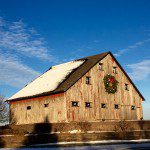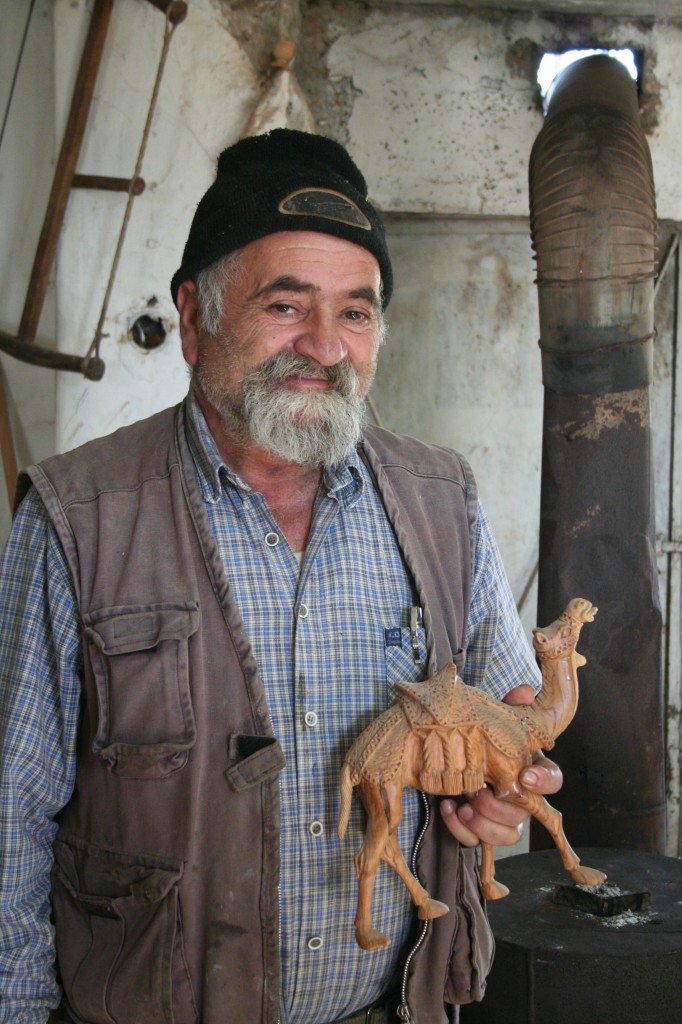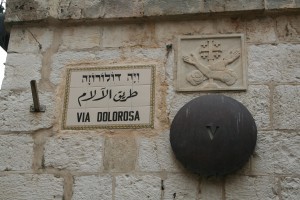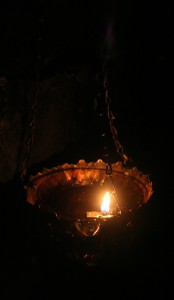Today we visit Bethlehem, as in O Little Town Of. Surrounded by rocky hills, Bethlehem is one of the most sacred places in Christianity, honored as the birthplace of both King David and Jesus. The city is just five miles south of Jerusalem, but since 1995 it has been part of the Palestinian National Authority rather than Israel. While many Palestinians have difficulties traveling across the border into Israel, tourists are free to come and go with only a brief stop at a checkpoint.
The primary holy site in Bethlehem is the Church of the Nativity. The Emperor Constantine and his mother Helena had a church constructed here around 325 A.D., building it on the spot which according to local tradition was the grotto where Jesus was born. Today’s church—parts of which date back to the fourth century—is shared by the Armenian, Greek Orthodox and Roman Catholic Churches. Visitors enter through a small opening called the Door of Humility (designed for easy defense in case of attack). At the front of the church, curved steps lead down into the grotto, where a silver star marks the spot of Jesus’ birth. As in the Church of the Holy Sepulchre, there is often a long wait to enter this sacred spot.

Some of you might perhaps have seen a YouTube video that went viral before Christmas, which showed monks fighting each other with brooms in this very church. On our tour I asked our guide if this scuffle really happened.
“Oh, yes,” he replied cheerfully. “They always fight like that when they’re cleaning the church before Christmas.”
(And that, my friends, is why I despair that there will ever be a solution to the Israeli-Palestinian conflict. This is a part of the world where even monks fight each other.)
Adjacent to the Church of the Nativity is the Church of St. Catherine, the place from which the annual midnight Christmas mass is broadcast around the world. In its courtyard stands a statue of St. Jerome, who lived here in the fifth century and who first translated the Bible into Latin, and underneath are crypts that are said to be the burial places of St. Jerome and other early saints.
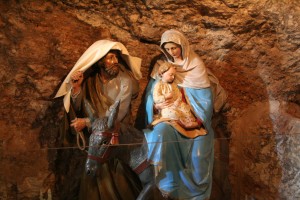
Bethlehem has two other major holy sites. Just a few blocks from the Church of the Nativity is a small white church that is built over a cave where the Holy Family is said to have taken shelter on their flight to Egypt. The legend says that as the innocents were being slaughtered by Herod’s men in Bethlehem, Mary nursed the baby Jesus to keep him quiet. Some of her milk is believed to have spilled on the stone of the cave, turning its walls white. In the small office next to the grotto you can get small packets of powdered milk that are said to have miraculous powers, particularly for women trying to conceive a child (being quite content with the two adult children I have, I didn’t partake).
Nearby is a place called Shepherds Fields, which commemorates the angels appearing to announce the birth of Jesus to the shepherds tending their flocks. Built in 1950 by the Franciscans, the sanctuary has the shape of a shepherd’s tent, with a charming fountain featuring quite adorable-looking sheep.
I was privileged to tour Bethlehem with Suzan Sahori, co-founder of the non-profit Bethlehem Fair Trade Artisans. A Palestinian Christian, Suzan spoke to our group about the difficulties of life on the West Bank. While she has a pass that allows her to travel back-and-forth relatively easily between Bethlehem and Jerusalem, the great majority of Palestinians do not have that freedom (including her own daughters). This has led to great economic and personal hardships for many.
Suzan’s organization represents nearly 100 Palestinian workshops where artisans create olive wood carvings, embroidery, olive oil soap, and mother of pearl pieces. Olive wood carving is a particularly time-honored craft in this city. For many centuries the small figurines created by the carvers of Bethlehem have been used as teaching tools for the Biblical story. Unfortunately, the ongoing political conflicts between Israel and the Palestinian Territories have led to a decline in tourism and so Suzan’s organization is working hard to market the artisans’ products internationally and be a source of support for economically distressed families.
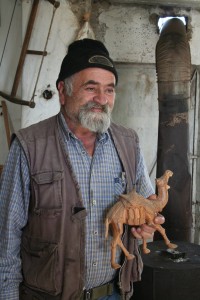
If you know of a church that might be interested in ordering Palestinian crafts for a Christmas bazaar or similar event (or you want to order some lovely pieces for yourself), I encourage you to browse their website at Bethlehem Fair Trade Artisans. The association ensures that the artisans receive a fair price for their labors but their handwork is also sold at reasonable prices.
I left Bethlehem in a somber mood, grateful to have seen this ancient holy place but troubled by unease. I thought of those fighting monks in the Church of the Nativity and of the intractable tensions between Israelis and Palestinians. Perhaps there is some small consolation in the fact that this part of the world has long been a place of conflict, situated as it is on a strategic land bridge between continents and home to a mix of religions and cultures. What is going on now is another chapter in a long saga.
“Pray for the peace of Jerusalem,” wrote the author of Psalm 122—a prayer that is still needed thousands of years later.


